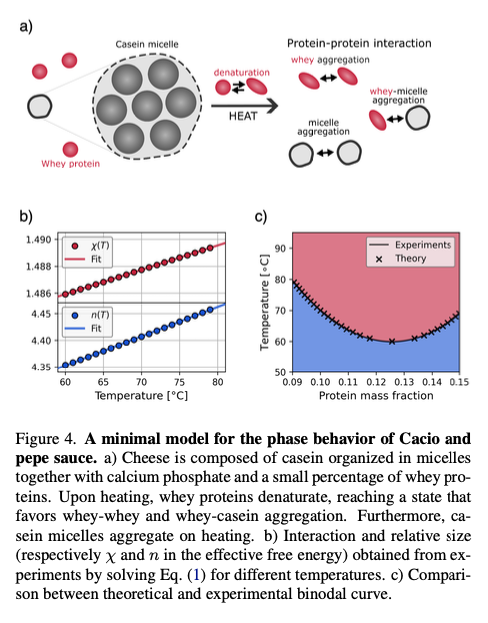Phase Behavior of Cacio and Pepe Sauce
Now you know!

Scientific article
Title: Phase Behavior of Cacio and Pepe Sauce
Authors: G. Bartolucci, D. M. Busiello, M. Ciarchi, A. Corticelli, I. Di Terlizzi, F. Olmeda, D. Revignas, and V. M. Schimmenti
Abstract: “Pasta alla cacio e pepe” is a traditional Italian dish made with pasta, pecorino cheese, and pepper. Despite its simple ingredient list, achieving the perfect texture and creaminess of the sauce can be challenging. In this study, we systematically explore the phase behavior of Cacio and pepe sauce, focusing on its stability at increasing temperatures for various proportions of cheese, water, and starch. We identify starch concentration as the key factor influencing sauce stability, with direct implications for practical cooking. Specifically, we delineate a regime where starch concentrations below 1% (relative to cheese mass) lead to the formation of system-wide clumps, a condition determining what we term the “Mozzarella Phase” and corresponding to an unpleasant and separated sauce. Additionally, we examine the impact of cheese concentration relative to water at a fixed starch level, observing a lower critical solution temperature that we theoretically rationalized by means of a minimal effective free-energy model. Finally, we present a scientifically optimized recipe based on our findings, enabling a consistently flawless execution of this classic dish.
Review
This paper is proof that no aspect of life is too small to overanalyze with the full force of science. Armed with phase diagrams and free-energy models, the authors have waged war on clumpy pasta sauce—and won. It’s a gloriously nerdy deep dive into the thermodynamics of Italian cuisine, with the bonus of a scientifically engineered Cacio e Pepe recipe for when your inner nonna fails you. A must-read for anyone who’s ever overthought their dinner.
- The harrowing tale of the “mozzarella phase,” where cheese proteins band together to ruin your meal.
- Why starch is the unsung hero of creamy sauces, and how to wield its powers like a culinary sorcerer.
- How to impress friends with pasta and casual mentions of binodal phase separation.
Prepare to be simultaneously amused, educated, and slightly bewildered by this heroic effort to quantify deliciousness.
Check it out yourself and let us know if a Roman would approve of the result!
Tips
Before applying the scientific method, here are a few tips: recipe from Giallo Zafferano
Or a variation of the traditional recipe by an Italian master of the culinary arts, Massimo Bottura.